3 Workouts To Make You Faster
Below, we’ll walk you through workouts and exercises to help you run faster. These drills teach you how to run fast longer and avoid injury. While workouts and strength work aren’t usually the most fun aspects of running, training to run faster will pay off when you do hit the pavement or the trails.
9. Practice Intensity With A Plyometric Workout
One way we like to build up intensity outside of a run is to use strength training. It’s like an introduction to the stress of breathing and working harder from the safety of your living room. Or a park, or wherever you choose to do this workout.
You’ll be combining bodyweight exercises–burpees with squat jumps. The workout is only four minutes long, so it’s a short amount of time to practice working intensely. Remember that the goal is to push but not injure, so don’t sacrifice good running form for speed or density.
Focus on proper form, and you’ll develop the techniques to running faster.
The Burpee:
- Start with your feet hip-width apart, standing tall, toes straight ahead.
- Hinge your hips back to place your hands on the ground in front of your feet.
- Now either step or jump your feet back to a straight arm plank.
- From here, do a “controlled crash” to the ground–chest and hips laid flat on the ground.
- Now snake your chest up, leaving the knees on the ground.
- Once the chest is off the ground, snap the hips to reverse the arch and bring the feet back into your hands, just under your hips.
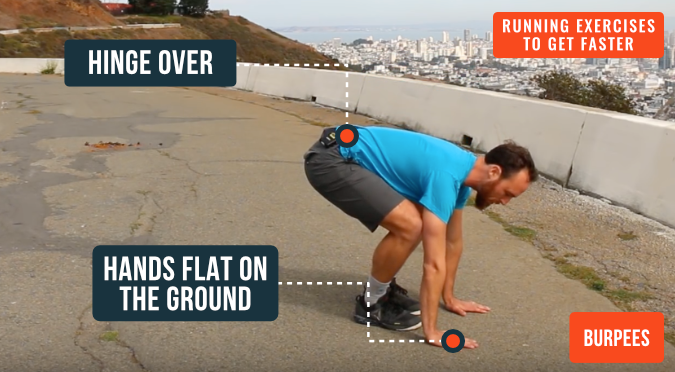
- Now, stand up.
- Raise your arms overhead and hop.
- That’s one burpee.
- *If that is not sustainable for more than a few reps, ditch the “fake push-up”. Simply step or jump out to the plank and immediately bring feet back in to stand.
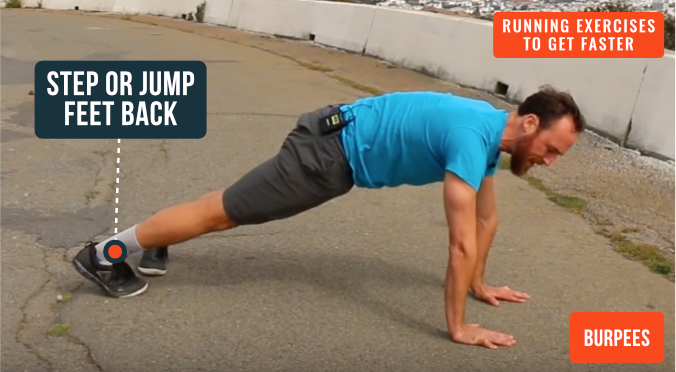
- You’re going to do as many QUALITY burpees as you can in 20 seconds.
- Then, rest for ten seconds and catch your breath. If you’re just starting out and need a little more time, take an extra ten seconds.
- Time to go again! Do as many QUALITY squat jumps as you can in 20 seconds.
- Rest for ten seconds.
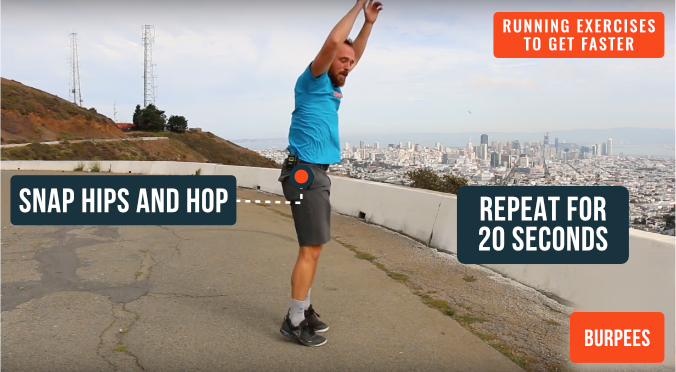
- Continue for four minutes total.
The Squat Jump
Now we’re ready to fire up the glutes and hamstrings with squat jumps. Here’s what the squat jump looks like:
- Stand tall, with your feet slightly wider than hip-width apart.
- With your toes pointing straight ahead, sit the hips back, and bend your knees slightly.
- Make sure your knees are pressed out laterally, meaning they don’t cave in.
- As you sit into the squat, bring your arms in front of you.
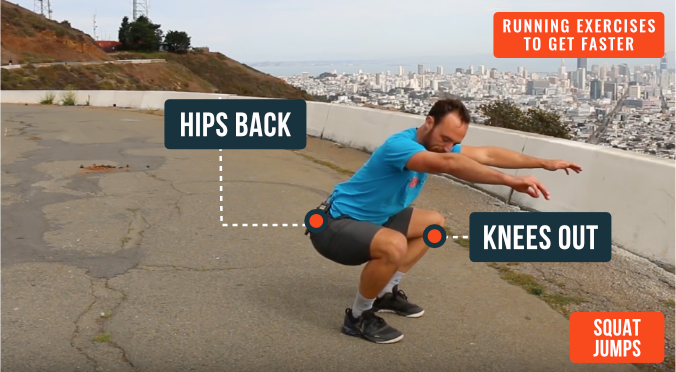
- Once your hips are as parallel to the ground as they can be, squeeze your butt and press it down towards your heels.
- From the depth of your squat, you’re going to throw your arms back behind you.
- At the same time, press your hips forward into full extension as your legs straighten.
- The momentum from the arms will help elevate you into a slight hop.
- Immediately from the landing of the hop, you’ll find your next squat position with the arms back in front.
- That’s one squat jump.
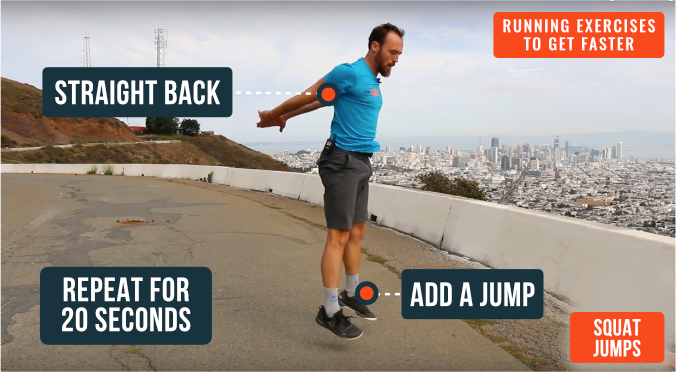
- Complete 20 seconds of squat jumps with ten seconds of rest in between sets for a total of four minutes.
Throw this into your training plan twice a week for strong leg muscles and awesome results!
Try these other full-body workouts to make you faster.
10. Train Your Hips To Increase Power Output
Our hips are the gas pedal for our running. The more we use them, the more power (and speed) we can generate! The hips not only help keep your hips stable but they also help your glutes to fire and propel you forward. With a stable pelvis, you’ll be putting your spine in a strong and safe position to avoid the low back pain that is so common among runners. Injury prevention and speed training all in one!
The Box Jump
The box jump is essentially a plyometric squat jump up to a higher surface. Here’s what it looks like:
- Start off standing tall.
- Next, drop into the squat the same way you do for the squat jumps, EXCEPT your arms will swing behind you.
- You’ll START to come out of the bottom the same way, EXCEPT your arms will now come forward.
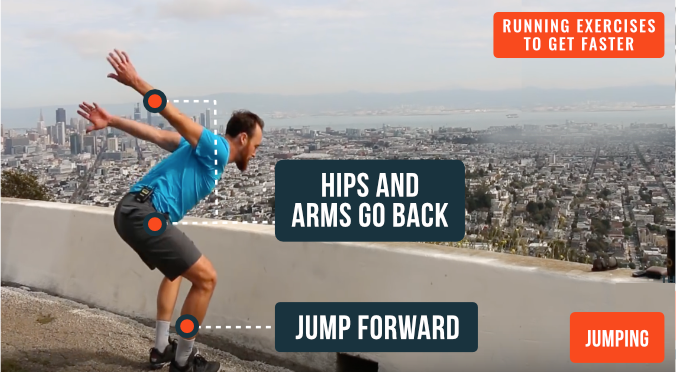
- As your feet are about to leave the ground for the jump, you’ll squeeze your core and tuck your knees up to your chest.
- Your legs will bend up in front of you and your feet will flex.
- This is your leverage for getting up to a higher surface.
- As you land, try to sink straight into the bottom position of the squat.
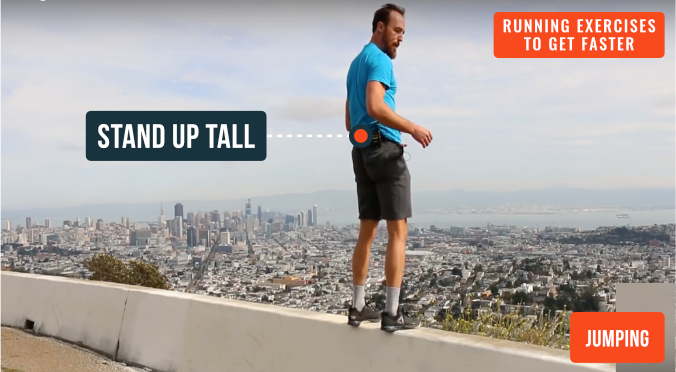
- Now, press out of your heels, squeeze your butt, and stand tall.
- Safely step down to the ground one foot down at a time.
- That’s one box jump.
A few things to be mindful of–especially if you’re brand new to these:
- Most gyms have multiple box heights. Don’t be afraid to play around to find the right height for you, even if that means starting low.
- If you’re outside and using a curb or other makeshift concrete raised surface, practice a few step-ups first to ensure you’ll clear it.
- Be confident. The higher and stronger you bring your knees up, the more success you will have.
Here’s a drill you can mix into your training:
1) Perform 5-10 box jumps.
2) Now, run 200-400 meters. It can be down the block, once around a track, or something similar.
3) Do another 5-10 box jumps.
4) Run 200-400 meters again.
5) Repeat for 3-5 rounds total.
This drill is awesome for increasing that hip strength and directly applying it to your running. Try throwing it into your training program once a week!
11. Run Faster To Get Faster
Want to know the secret of how to get faster at running? Try running faster.
The last of our running exercises to get faster! Fartlek means “speed play” in Swedish, where the concept was born. By using different types of speed work and interval training on your runs you’ll practice finding different “running gears.” By avoiding always running at the same pace, especially on those longer distances, you’ll get better at pushing through performance plateaus.
The Fartlek technique for runners is nothing short of EFFECTIVE. Try this out on your next run:
- You will pick sections of your run to “push it” on. You make the rules.
- Pick something that you’ll encounter a number of times over your course: stairs, a telephone pole, a hill.
- Each time you get to whatever you chose, you have to run faster for the entirety of that obstacle. We’re not all-out sprinting here, but it should be about 70-80% of your max speed.
- If you picked hills, you need to kick it into the next gear until you’re at the top of the hill. This strategy will net you two birds with one stone: speed and hill training!
- You can then return to a slower pace until you hit the next hill or obstacle
- Throw in five to ten lunges in between each loop to weave in some strength training
- You can do this on the treadmill by randomly throwing in sections at a faster pace. Try to pick up the speed during commercials, for example, and recover until the next one.
This is an awesome way to make running faster fun and interesting!
How to Run Longer Bonus Tips
Sometimes, speed comes from endurance. Being able to run longer essentially means you can run faster for a longer period of time—since, you could walk at any point and make up the same distance in a much longer time.
Here are a few of our top tips to help you run longer (and faster):
12. Manage Your Cadence
As we get tired during a longer run, one of the first things to go is our cadence–also known as how many steps you take in one minute. Everyone has a natural cadence. You can determine yours using a simple metronome app.
As you notice yourself getting fatigued throughout the later miles of your run, check your cadence. When we get tired, we start to shuffle our feet. When you feel that happening, use your metronome to check your cadence. Adjust your cadence as needed to keep your form strong so you don’t waste any more energy and can finish strong.
13. Develop Mental Strength
Even if you have the best plan and running group, learning how to run longer requires mental toughness. Some days you’re going to feel great–and some days you just won’t.
Even with the best preparation and a good warm-up, your legs might feel heavy or you might seem more tired than usual earlier in the run. This can happen in a race, too.
How do you combat an off day when you’re aiming to run longer? Find what works for you. For some, it’s finding a killer playlist that motivates you even when you’re not feeling your best. Others enjoy using mental imagery, such as imagining yourself crushing your PR on race day.
Try interval training to spice things up and keep your run going. On a rough day, I like to count light posts or markers on the trail–I know each one gets me closer to the end of the run. Often, I discover I’ve stopped counting after a couple of miles because my legs and body have gotten on board. Don’t forget to check out our motivational videos on developing mental toughness!
Of course, there’s a caveat. If you have the pain of an injury, you have to cut a run short and tend to the injury. Don’t push through just to complete a run–you’ll only make it worse.
14. Breathe Through Your Nose
If you track how many miles you are running, focus on breathing in through your nose and out through your mouth for the first minute of each mile. If you don’t count miles, just breathe in through your nose and out through your mouth the first minute of every 10 minutes or so.
Why? Breathing this way helps you communicate with your diaphragm. It builds more stability in your run and keeps you from shifting from side to side while you stride. Ultimately, this prevents you from wasting energy so you can get the most out of each mile.
15. Take Your Time
You might be eager to nail your first long run, but you’ll likely end up increasing your injury risk if you overdo it. Help prevent injuries and burnout using the 10 percent rule–don’t up your weekly mileage by more than about 10 percent each week.
Let’s say you’re running 30 miles per week and you want to get to 45 miles per week before your upcoming 10k race. It doesn’t seem like a lot, but just adding three to four miles per week makes a big difference. Here’s what your training plan might look like:
- Week One: 30 miles with a six-mile long run
- Week Two: 33 miles with a seven-mile long run
- Week Three: 36 miles with an eight-mile long run
- Week Four: 40 miles with a nine-mile long run
- Week Five: 45 miles with a 10-mile long run
In just five weeks, you’ve increased the amount of time you are running and your mileage significantly–and are up to a 10-mile long run. Awesome! Now, you might be wondering how to make the most of those long runs. Keep reading.
Advanced Training Techniques to Get Faster at Running
Once you’ve incorporated all of the tips above, you might eventually hit a plateau—it happens to everyone. When that time comes (and it inevitably will), you’ll need to dig deep into more advanced training methods to get faster at running. Here are a few of our favorites:
16. Heart Rate Training
Heart rate training involves monitoring your heart rate during runs to ensure you’re training at the right intensity. By staying within specific heart rate zones, you can optimize your training for various goals, such as improving endurance, increasing speed, or enhancing recovery.
Here’s a breakdown of heart rate zones and their benefits:
- Zone 1 (50-60% of max HR): Very light activity, ideal for warm-ups, cool-downs, and recovery.
- Zone 2 (60-70% of max HR): Light aerobic training, perfect for building aerobic endurance and burning fat.
- Zone 3 (70-80% of max HR): Moderate aerobic training, great for improving cardiovascular fitness.
- Zone 4 (80-90% of max HR): Threshold training, which helps improve your lactate threshold and overall speed.
- Zone 5 (90-100% of max HR): High-intensity training, used for interval training and building maximum speed.
17. VO2 Max Improvements
VO2 max is the maximum rate at which your body can consume oxygen during intense exercise. Improving your VO2 max can significantly enhance your running performance. Here are some effective ways to boost your VO2 max:
- High-Intensity Interval Training (HIIT): Alternating between short bursts of intense activity and periods of rest or low-intensity exercise can effectively increase your VO2 max.
- Tempo Runs: Running at a challenging but sustainable pace for a prolonged period helps improve your body’s ability to clear lactate and use oxygen more efficiently.
- Hill Workouts: Running uphill increases the intensity of your workout, challenging your cardiovascular system and improving your VO2 max.
18. Strength Training for Runners
Strength training is essential for improving running efficiency and preventing injuries. By building stronger muscles, you can enhance your running form, power, and endurance. Here are some key strength exercises for runners:
- Squats and Lunges: These exercises target your quads, hamstrings, and glutes, which are crucial for running power.
- Deadlifts: Strengthen your posterior chain, including your hamstrings, glutes, and lower back.
- Core Workouts: Planks, Russian twists, and leg raises help stabilize your core, which is vital for maintaining good running form.
- Plyometrics: Exercises like box jumps, jump squats, and burpees improve your explosive power and agility.
Incorporating these advanced training techniques into your routine can help you break through plateaus and reach new levels of running performance. Remember to always listen to your body and adjust your training as needed to avoid overtraining and injuries.
How to Run Faster AND Longer Without Getting Tired
Endurance runners need to learn to maintain their speed for longer distances. While you’ll likely always be tired by the end of a fast, long run, you can train your muscles and heart to deal with the fatigue better.
Learning how to run faster and longer without getting tired doesn’t really require a difference in training. Still, practice your strides and tempo run, and then pour lots of energy into your Z1 and Z2 easy runs.
Doing this consistently over weeks, months, and years helps you build the aerobic base you need to run faster and longer without getting tired.
There’s no magic pill or special workout—it’s all about consistency. What’s hard today becomes easy (or easier) tomorrow. Keep training, prioritize recovery, and avoid injuries. These are the not-so-secret sauces to building your endurance and speed.
Building a Strong Aerobic Base
1. Gradual Increase in Mileage:
To safely build endurance, increase your weekly running distance by no more than 10%. This gradual progression allows your body to adapt without the risk of injury, ensuring consistent improvement in your endurance capabilities.
2. Long, Slow Distance Runs (LSD):
LSD runs are vital for enhancing mitochondrial density and capillary networks, crucial for endurance. These runs, performed at a comfortable pace, improve your body’s efficiency in utilizing oxygen and fuel over long distances.
3. Incorporate Tempo Runs:
Tempo runs, characterized by sustained effort, are essential for teaching your body to maintain a faster pace over longer periods. Integrating these into your routine involves running at a challenging yet manageable pace for a set duration, effectively bridging the gap between speed and endurance training.
Mental Toughness and Focus
1. Mindfulness and Visualization:
Mental preparation is as crucial as physical training. Visualization and mindfulness can significantly boost performance. Regularly practicing visualizing yourself successfully completing races, maintaining speed and endurance, can prepare your mind to face the actual challenges of long-distance running.
2. Overcoming Mental Barriers:
Breaking down a long run into smaller segments makes the task less intimidating. Set mini-goals or milestones within your run and focus on reaching one segment at a time. This approach helps manage mental fatigue and keeps motivation levels high throughout the run.
3. Maintaining Focus:
Staying focused during long runs is crucial. Mindful running techniques, such as concentrating on your breathing, the rhythm of your steps, or the surrounding environment, can help keep your mind engaged and prevent it from dwelling on fatigue or discomfort.
Specific Training Methods
1. Interval Training:
Interval training, involving alternating between high-intensity bursts and recovery periods, is pivotal for enhancing both speed and endurance. By stressing your cardiovascular system in short, intense bursts, you increase your aerobic capacity, allowing you to maintain a faster pace for longer durations during races.
2. Hill Workouts:
Hill training is a powerful tool for building leg strength, improving running economy, and boosting cardiovascular fitness. Running up hills challenges your muscles and heart, enabling you to develop the power and stamina needed to maintain speed on varied terrains over long distances.
3. Strength and Flexibility Training:
A balanced routine of strength and flexibility exercises, targeting the core, legs, and upper body, supports efficient running form and enhances endurance. Incorporating exercises like squats, lunges, planks, and stretches into your routine strengthens key muscle groups and increases flexibility, reducing the risk of injuries and improving overall running performance.
Frequently Asked Questions (FAQs)
Why is it so difficult to run fast?
When you push your body to its limit, it reacts physiologically in defense response to the discomfort of running fast. These reactions can come in the form of oxygen deficit, inefficient muscle-fiber recruitment, a build-up of lactic acid, a feeling that your legs are on fire (!!!) and effort overload for your brain.
Though these are natural reactions for your body, there are ways to train the body and mind to handle the discomfort of reaching new speeds and adapting to harder efforts.
So, what can you do to run faster?
Improving your speed is not as simple as just running faster. There are many small changes that can be implemented into your training to run faster. Follow these workouts and exercises designed to make you a faster, stronger runner—and stick to the 8 tips we mentioned above to learn how to run fast consistently.
How to run longer?
Most athletes don’t want to just know how to run faster—they want to know how to run faster longer. First, avoid injury. Injuries will set back your speed and distance. Next, follow the training workouts, exercises, and techniques above—they’ll help you build up consistent, reliable strength and form that’ll help you run faster throughout a 5K or an ultramarathon.
What muscles make you run faster?
Great question. Running fast incorporates a range of muscles, and these are the same muscles responsible for slow running, hiking, and even walking:
- Calves
- Quads
- Hamstrings
- Glutes
- Feet
- Core
You will feel the different emphasis on certain muscles when you push the pace. For example, when you do sprints or tempo runs, you’ll likely feel increased tension on your hamstrings. Training these muscles to endure heavier loads will prepare you for faster efforts.
Mix And Match!
How you get faster at running is up to you. Use some or all of these strategies in your training schedule to see great results in your 5K pace and longer-distance race times—from cross-country to long-distance running.
Now that you’re at the finish line, take a minute to download our app and find a workout to boost your running pace. Audio workouts, follow-along videos, help from the coaches, and more tips on how to run faster all await you in the app!